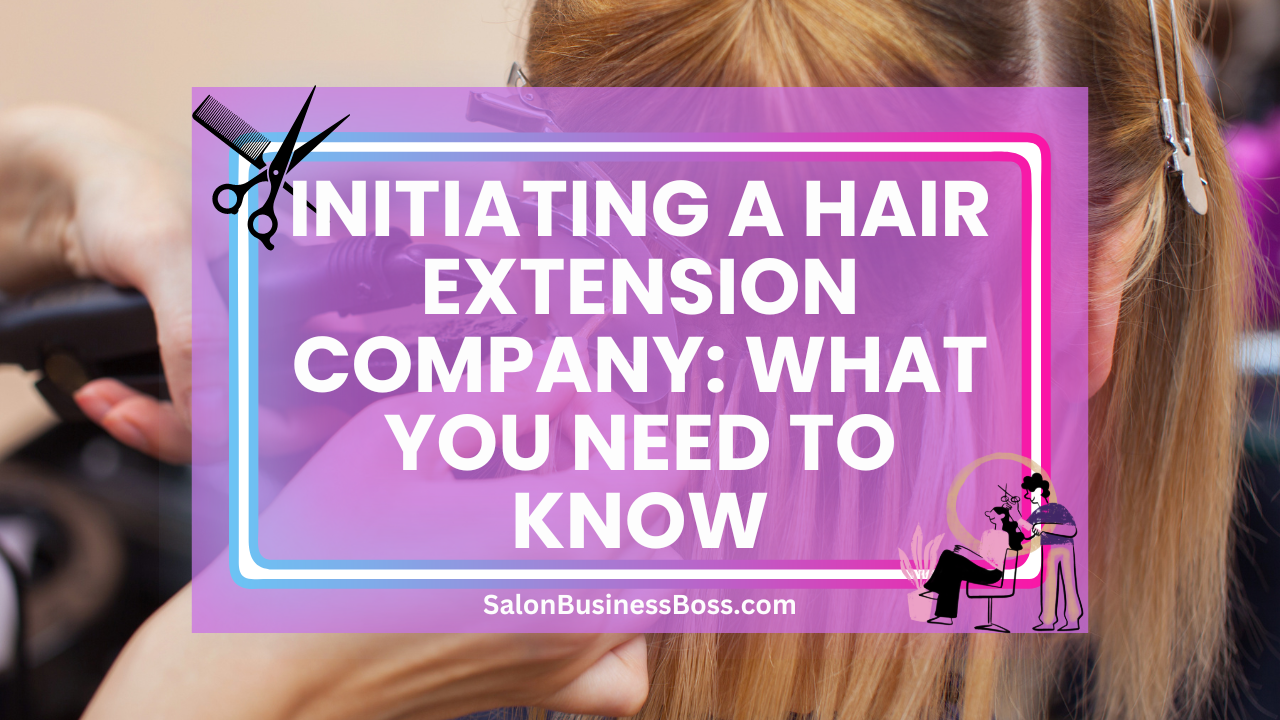Starting a hair extension company can be a rewarding venture for individuals passionate about beauty and fashion. The hair extension industry continues to thrive, offering a wide range of opportunities for entrepreneurs. However, like any business, establishing a successful hair extension company requires careful planning, dedication, and knowledge.
Start a hair extension company by completing a training course to master application techniques. Choose a unique business name and structure, ensuring legal compliance. Source top-quality hair extensions, create a user-friendly e-commerce website, implement a strategic marketing plan, and determine competitive pricing.
1. Complete a Hair Extensions Training Course

Before embarking on your hair extension business journey, it is vital to equip yourself with the necessary skills and knowledge through a comprehensive hair extensions training course. These courses are designed to provide you with a solid foundation in the art and science of hair extensions, covering a wide range of topics.
Enrolling in a reputable hair extensions training course offers numerous advantages. Firstly, you will gain insights into various types of hair extensions, including clip-ins, tape-ins, micro-links, and fusion extensions. Understanding these different methods will enable you to cater to diverse client preferences and requirements.
You will learn the correct application techniques to ensure seamless and long-lasting results. Proper application is critical to maintaining customer satisfaction and earning positive reviews, ultimately driving word-of-mouth referrals and repeat business.
Maintenance is another crucial aspect covered in these courses. Learning how to guide your clients on maintaining their extensions will help prolong the lifespan of the hair and enhance their overall experience.
These courses keep you updated with the latest industry trends, ensuring that you stay relevant in the competitive hair extension market. Techniques and styles can evolve rapidly, and being informed will help you offer cutting-edge services to your clientele.
Completing a hair extensions training course not only boosts your technical expertise but also instills confidence in your abilities. Customers are more likely to trust a trained professional, increasing your credibility and attracting a larger customer base.
Read more about: How to Open Up Your Own Hair Salon: A Journey to Hairdressing
2. Choose Your Business Name and Brand Identity
Selecting the right business name and establishing a distinctive brand identity are essential steps in laying the foundation for your hair extension company.
Your business name should be memorable, easy to pronounce, and relevant to your industry. It should also convey the essence of your brand and the quality of services you provide. Before finalizing the name, conduct thorough research to ensure that it is not already in use by another business, and check for domain availability to secure a matching website.
Once you have settled on a business name, it’s time to create a brand identity that aligns with your vision. Design a professional logo that visually represents your company and captures the attention of potential customers. The logo should be versatile and easily adaptable to various marketing materials and platforms.
Choosing a consistent brand color palette is equally crucial. Colors evoke emotions and play a significant role in brand recognition. Select colors that complement your company’s values and target audience preferences.
Integrate your brand identity across all touchpoints, including your website, social media profiles, business cards, and marketing materials. This cohesive approach will help establish a strong brand presence, fostering brand loyalty among customers.
By investing time and thought into choosing your business name and building a compelling brand identity, you will set the stage for a successful and memorable hair extension business. A well-crafted brand identity will resonate with your target audience and contribute to the long-term success of your venture.
3. Choose a Business Structure
Selecting the appropriate business structure is a critical decision that will have legal and financial implications for your hair extension company. The four most common options are sole proprietorship, partnership, limited liability company (LLC), and corporation.
A sole proprietorship is the simplest form of business ownership, where you are the sole owner and responsible for all aspects of the business. While it offers simplicity and full control, it also means that you are personally liable for any debts or legal issues that may arise.
A partnership involves two or more individuals sharing ownership and responsibilities. Partnerships offer shared resources and expertise, but also share liability and decision-making authority.
An LLC is a popular choice for small businesses as it combines the liability protection of a corporation with the flexibility and tax advantages of a partnership. It shields personal assets from business debts and obligations, offering more security to the owners.
A corporation is a separate legal entity from its owners, providing the highest level of liability protection. However, it involves more complex legal and tax requirements, making it better suited for larger businesses.
To make an informed decision, consult with a legal or financial advisor who can evaluate your business goals, risk tolerance, and potential growth prospects. They will help you determine the most suitable structure that safeguards your personal assets, minimizes tax burdens, and aligns with your long-term business plans.
4. Legal Requirements and Permits
Starting a hair extension company involves navigating various legal requirements and obtaining necessary permits. The first step is to register your business with the appropriate government agencies. Depending on your location and business structure, you may need to acquire a federal employer identification number (EIN).
Research local regulations pertaining to beauty services to ensure compliance. Obtain any required licenses or permits specific to your industry and locality. This may include health department approvals, salon licenses, and seller’s permits for retail sales.
Ensuring compliance with health and safety standards is crucial, especially when dealing with beauty and salon services. Adhere to sanitation guidelines and maintain a clean and hygienic environment for your clients.
Fulfilling legal formalities at the outset of your venture will prevent potential legal issues in the future. It will also help you gain credibility and build trust with customers, as they will have confidence in your commitment to following regulations and providing a professional and lawful service. Seeking legal advice can be beneficial to navigate the complexities of the legal landscape and ensure a smooth and lawful start to your hair extension company.
5. Source High-Quality Hair Extensions

The success of your hair extension company hinges on the quality of the products you offer. It is crucial to source high-quality hair extensions to build trust with your customers and establish a loyal clientele. Look for reputable suppliers who specialize in real human hair extensions.
Authentic human hair extensions offer a natural look and feel, providing a seamless blend with your customers’ hair. Ensure that the hair is ethically sourced and of premium grade to maintain customer satisfaction and positive reviews.
Consider offering a variety of hair textures, lengths, and colors to cater to a diverse range of clients. Different individuals have unique preferences, and providing a wide selection will enhance your marketability.
Building strong relationships with reliable suppliers is essential to maintain a consistent supply of quality products. Look for suppliers with a track record of delivering on time and maintaining product integrity.
Conduct regular quality checks to ensure that the hair extensions meet your company’s standards. Customer feedback can also be valuable in identifying any areas for improvement and ensuring that you continue to offer top-notch products.
Read more about: How to Start a Hair Business: Embarking on Your Hair Business Adventure
6. Establish an E-commerce Website
In the digital era, having a robust online presence is vital for the success of your hair extension company. An e-commerce website serves as a virtual storefront, allowing customers to explore and purchase your products from the comfort of their homes.
Design an e-commerce website that is visually appealing and reflects the aesthetics of your brand. Opt for a user-friendly interface that makes navigation effortless for customers. Ensure that the website is optimized for mobile devices to cater to the growing number of mobile shoppers.
Include high-quality images of your hair extension products, showcasing different styles, colors, and lengths. Invest in professional photography to provide accurate representations of your products.
Detailed product descriptions are crucial to help customers make informed decisions. Include information about the hair type, texture, length, and care instructions. Highlight the unique selling points of each product to entice potential buyers.
Implement a secure payment gateway and prioritize customer data protection. Building trust with your customers is vital for online transactions, and security measures will instill confidence in their purchasing experience.
A well-designed e-commerce website will broaden your reach, attract new customers, and increase sales. It also serves as a platform for brand building and allows you to engage with your audience through informative content and social media integration.
7. Develop a Marketing Strategy
Marketing is the cornerstone of your hair extension company’s growth and success. Start by identifying your target audience—the individuals most likely to be interested in your products. Understanding their preferences and needs will help you tailor your marketing efforts effectively.
Utilize social media platforms as powerful tools to showcase your hair extension products. Platforms like Instagram, Facebook, and Pinterest offer visual appeal, enabling you to share high-quality images and engaging content. Leverage these platforms to create a brand persona, interact with your audience, and build a community around your brand.
Collaborating with influencers in the beauty industry can significantly expand your reach and credibility. Seek out influencers whose audiences align with your target market and engage them to promote your products. Influencers can create authentic content that showcases your hair extensions in real-life settings, driving interest and conversions.
Consider email marketing to nurture relationships with existing customers and attract new ones. Offer exclusive promotions and valuable content to encourage repeat business and customer loyalty.
Consistency is key in your marketing strategy. Maintain a regular posting schedule, respond to customer inquiries promptly, and actively engage with your audience. By building a strong online presence and fostering connections with your target audience, you can increase brand awareness, attract more customers, and drive sales for your hair extension company.
8. Pricing and Profitability
Determining the right pricing for your hair extension products is essential for striking a balance between attracting customers and maintaining profitability. Start by calculating the total cost of producing and selling each product, including the cost of materials, labor, packaging, and any overhead expenses.
Conduct thorough market research to understand the pricing strategies of your competitors and the prevailing market rates. This information will provide valuable insights into setting competitive prices that appeal to your target audience.
While competitive pricing is important, do not undervalue your products. Offering high-quality hair extensions justifies a reasonable profit margin. Customers are willing to pay a premium for quality, and undervaluing your products may inadvertently signal lower quality to potential buyers.
Consider offering different price points and bundle deals to accommodate a diverse customer base. This approach allows customers with varying budgets to access your products.
Monitor the performance of your pricing strategy regularly and be prepared to adjust as needed. Pricing is not set in stone, and market conditions and customer preferences can change over time. A flexible approach will help you adapt and ensure your hair extension company remains profitable and sustainable.
Conclusion
Starting a hair extension company requires a combination of passion, knowledge, and business acumen. By completing a hair extensions training course, choosing a suitable business structure, and offering high-quality products and exceptional customer service, you can lay the foundation for a successful and thriving hair extension business. With dedication and a strong online presence, you can position your brand as a reputable name in the hair extension industry, attracting a loyal customer base and achieving long-term success.
Frequently Asked Questions

1. Do I need a physical store or salon?
A physical location is not necessary initially; you can offer mobile services or work from home.
2. How can I ensure the quality of my hair extension products?
Build relationships with reliable suppliers and conduct thorough quality checks on the products.
3. Is it possible to sell hair extensions internationally?
Yes, with proper shipping arrangements and international marketing, you can reach a global customer base.
To learn more on how to start you own salon checkout my startup documents here.
Please note that the contents of this blog are for informational and entertainment purposes only and should not be construed as legal advice. Any action taken based on the information provided in this blog is solely at your own risk. Additionally, all images used in this blog are generated under the CC0 license of Creative Commons, which means they are free to use for any purpose without attribution.

About the author. Entrepreneur and Salon Business Fan.
Hi! I am Shawn and I am a happy individual who happens to be an entrepreneur. I have owned several types of businesses in my life from a coffee shop to an import and export business to an online review business plus a few more and now I create online salon business resources for those interested in starting new ventures. It’s demanding work but I love it. I do it for those passionate about their business and their goals. That’s why when I meet a salon business owner, I see myself. I know how hard the struggle is to retain clients, find good employees and keep the business growing all while trying to stay competitive.
That’s why I created Salon Business Boss: I want to help salon business owners like you build a thriving business that brings you endless joy and supports your ideal lifestyle.

